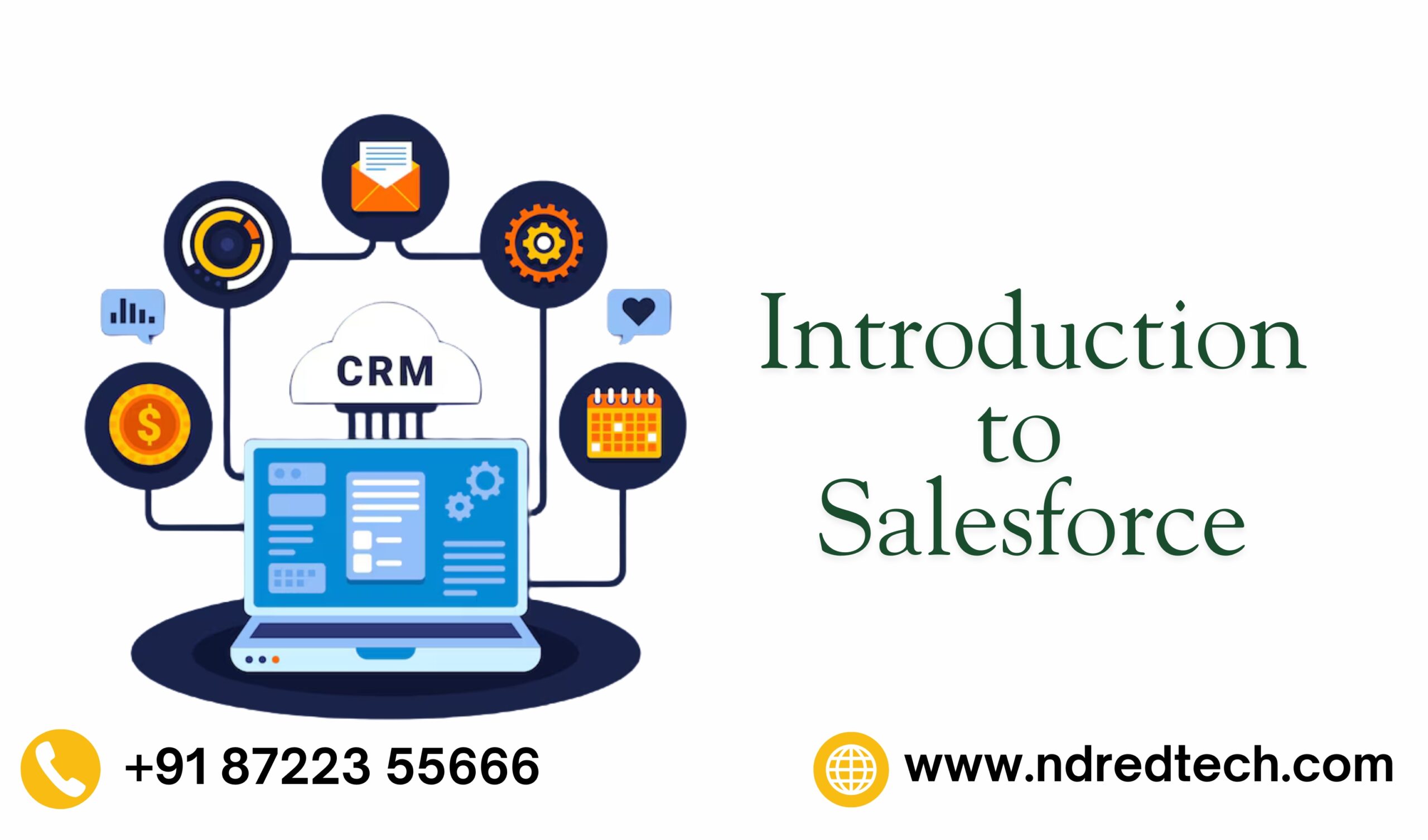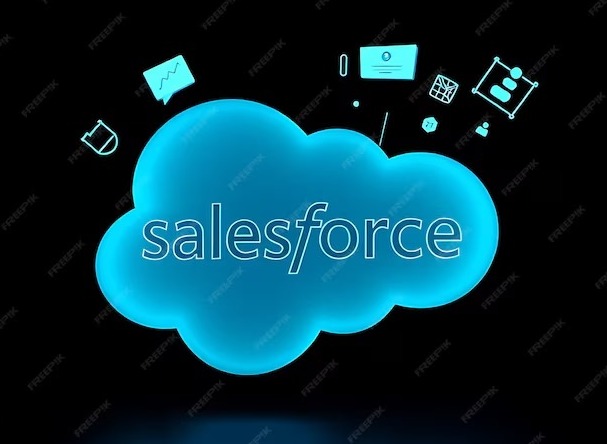What is Salesforce?
Salesforce is a cloud-based Customer Relationship Management (CRM) platform that helps businesses manage sales, customer service, marketing, and other business processes. It allows companies to connect with customers, streamline workflows, and automate tasks using cloud technology.
Overview of Cloud Computing & CRM
1.Cloud Computing Overview
Cloud computing is the delivery of computing services (servers, storage, databases, networking, software, analytics, and intelligence) over the internet to offer faster innovation, flexible resources, and scalability.
Types of Cloud Computing:
- Public Cloud – Services offered over the internet and shared across multiple organizations (e.g., AWS, Azure, Google Cloud).
- Private Cloud – Dedicated infrastructure for a single organization.
- Hybrid Cloud – A mix of both public and private clouds.
Cloud Service Models:
- IaaS (Infrastructure as a Service) – Provides virtualized computing resources (e.g., AWS EC2, Azure VM).
- PaaS (Platform as a Service) – Provides a platform for application development (e.g., Heroku, Google App Engine).
- SaaS (Software as a Service) – Delivers software applications over the internet (e.g., Salesforce, Google Drive).
2.Customer Relationship Management (CRM)
CRM is a strategy and technology for managing an organization’s relationships and interactions with customers and potential customers. It helps improve customer service, sales, and marketing efforts.
Types of CRM:
- Operational CRM – Automates sales, marketing, and service processes (e.g., Salesforce Sales Cloud).
- Analytical CRM – Analyzes customer data for decision-making (e.g., Salesforce Einstein Analytics).
- Collaborative CRM – Improves communication between businesses and customers (e.g., Salesforce Chatter).
Benefits of CRM:
- Centralized customer data
- Improved customer service
- Better sales tracking & forecasting
- Enhanced marketing automation
- Increased customer retention
How Salesforce Uses Cloud Computing & CRM?
Salesforce is a cloud-based CRM platform that helps businesses manage customer relationships efficiently. It offers:
- SaaS – Salesforce CRM is accessed via a web browser without installation.
- PaaS – Salesforce provides a platform (Force.com, Heroku) for developers to build custom applications.
- AI & Analytics – Uses AI (Einstein Analytics) for customer insights and decision-making.
Salesforce Editions & Licenses
1.Salesforce Editions
Salesforce provides multiple editions with varying features and pricing.
A. Salesforce Editions for Sales & Service Cloud:
1.Essentials
- Best for small businesses
- Basic CRM features (Accounts, Contacts, Leads, Opportunities)
- Supports up to 10 users
- Limited automation and customization
2.Professional
- Suitable for growing businesses
- Advanced CRM features (Forecasting, Custom Reports)
- No user limit
- Some automation & integrations
3.Enterprise
- Ideal for medium to large businesses
- Full automation & customization options
- Workflow rules, API access, and complex security controls
- Highly scalable
4.Unlimited
- Best for large enterprises
- 24/7 premium support
- Unlimited customizations and sandboxes
- Advanced analytics & AI capabilities
5.Developer Edition (Free)
- For developers to test and build applications
- Includes API access and customization options
- Limited data storage
B. Other Salesforce Editions:
- Marketing Cloud Editions – Based on features like Email Studio, Social Studio, and Advertising Studio.
- Commerce Cloud Editions – Different plans for B2B and B2C e-commerce businesses.
- Experience Cloud Editions – Used for customer and partner portals.
- Nonprofit & Education Editions – Special packages for nonprofits and educational institutions.
2.Salesforce Licenses
Salesforce licenses determine what features a user can access within an edition.
A. User Licenses:
- Salesforce License – Full access to CRM features.
- Salesforce Platform License – Limited CRM access; used for custom applications.
- Chatter Free/Plus – For internal collaboration (limited CRM access).
- Identity License – For users needing single sign-on (SSO) access.
B. Feature Licenses:
- Knowledge User – Allows access to the Knowledge Base.
- Marketing User – Enables email and campaign management.
- Service Cloud User – Provides access to case management features.
C. API & Integration Licenses:
- Integration User License – Used for API access and automation.
- Partner & Customer Community Licenses – For external users in Experience Cloud.
Understanding Salesforce Architecture
Salesforce is built on a multi-tenant cloud architecture, meaning multiple customers share the same infrastructure while keeping their data secure and separate. It follows a layered structure that ensures scalability, security, and customization.
1.Key Components of Salesforce Architecture
A. Multi-Tenant Architecture
- Multiple businesses (tenants) share the same Salesforce infrastructure.
- Each tenant’s data is isolated and secure.
- Reduces hardware and maintenance costs.
B. Metadata-Driven Architecture
- Salesforce stores customizations and configurations as metadata (data about data).
- Allows easy customization without affecting the core system.
- Updates from Salesforce do not break existing customizations.
C. Cloud-Based Infrastructure
Salesforce operates entirely in the cloud, eliminating the need for on-premise servers.
2.Layers of Salesforce Architecture
A. Multi-Tenant Cloud (Database Layer)
- Uses Oracle Database to store records.
- Ensures data separation using Organization ID and User Permissions.
B. Application Services Layer
- Manages business logic and automation.
- Includes Apex (programming language), Lightning Components, and Visualforce pages.
- Processes user requests and workflows.
C. User Interface (UI) Layer
- Provides a front-end for users to interact with Salesforce.
- Includes Classic UI and Lightning Experience (modern UI).
- Accessible via web browser, Salesforce Mobile App, or API.
D. Security & Sharing Model
- Uses profiles, roles, permission sets, and sharing rules to control data access.
- Protects against unauthorized access while enabling collaboration.
E. APIs & Integration Layer
- Salesforce supports REST, SOAP, and GraphQL APIs for integration.
- Connects with third-party applications like ERP, marketing tools, and databases.
3.How Salesforce Processes a User Request
- User logs in – Authentication via OAuth/SAML.
- Request goes to Application Layer – Apex, Workflows, and Processes execute business logic.
- Data is retrieved from the Database Layer – Using SOQL queries.
- Processed data is sent to UI Layer – Displays on Lightning Experience or Mobile App.
Why is Salesforce Architecture Important?
- Scalability – Handles millions of users and transactions.
- Security – Multi-layered security controls protect data.
- Flexibility – Allows custom development with metadata-driven changes.
- Integration – Connects with external systems seamlessly.
Salesforce Key Features
Salesforce provides a wide range of features that help businesses manage customer relationships, automate processes, and analyze data efficiently. Below are the key features of Salesforce:
1.Customer Relationship Management (CRM)
- 360-Degree Customer View – Stores all customer interactions, history, and preferences in one place.
- Contact & Account Management – Manage customer profiles, company details, and relationships.
- Lead & Opportunity Management – Track sales leads and deals through the pipeline.
2.Sales Automation
- Sales Cloud – Automates lead tracking, deal closures, and forecasting.
- AI-Powered Sales Insights – Uses Salesforce Einstein to predict sales trends.
- Pipeline Management – Helps sales teams manage and forecast revenue.
3.Marketing Automation
- Marketing Cloud – Enables personalized email, social media, and ad campaigns.
- Journey Builder – Automates customer engagement across channels.
- Lead Nurturing – Engages potential customers with targeted campaigns.
4.Customer Service & Support
- Service Cloud – Provides case management, live chat, and AI-powered chatbots.
- Knowledge Base – Helps customers find solutions through self-service.
- Omni-Channel Support – Manages customer queries across phone, email, chat, and social media.
5.AI & Analytics (Einstein AI)
- Predictive Analytics – Forecasts sales trends and customer behavior.
- Automated Insights – Provides recommendations for better decision-making.
- Sentiment Analysis – Analyzes customer feedback and interactions.
6.Customization & Development
- AppExchange – A marketplace with thousands of Salesforce apps and extensions.
- Apex Programming – Custom development using Salesforce’s programming language.
- Lightning Components – Drag-and-drop UI customization without coding.
7.Integration Capabilities
- REST & SOAP APIs – Connect Salesforce with other business applications.
- Third-Party Integrations – Works with tools like Slack, Outlook, QuickBooks, and ERP systems.
- Mulesoft (Integration Cloud) – Enables seamless data integration between systems.
8.Security & Compliance
- Role-Based Access Control (RBAC) – Users get access based on their roles.
- Data Encryption & Backup – Ensures sensitive customer data is secure.
- GDPR & HIPAA Compliance – Meets industry security and privacy standards
9.Mobile Accessibility
- Salesforce Mobile App – Allows users to manage CRM on the go.
- Offline Mode – Work without an internet connection and sync later.
- Push Notifications – Get real-time alerts for leads, tasks, and approvals.
10.Workflow Automation
- Process Builder – Automates business processes with a simple UI.
- Flow Builder – Advanced automation for complex workflows.
- Approval Processes – Route records for approval based on predefined rules.


